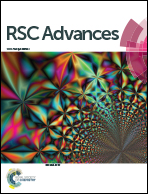DFT study of superhalogen and superalkali doped graphitic carbon nitride and its non-linear optical properties
Abstract
DFT calculations are carried out to investigate nonlinear optical (NLO) properties of superhalogen (BCl4) and superalkali (NLi4) doped graphitic carbon nitride (GCN). It is noted that the geometries of doped GCN are sufficiently stable. The energy gap for GCN is 3.89 and it reduces to 0.53 eV in our designed molecule G4. Change in the dipole and transition dipole moment is observed along with small transition energies which are responsible for higher hyperpolarizabilities. Doped GCN has larger first and second hyperpolarizabilities which are basic requirements for NLO response. The second hyperpolarizability of GCN enhances from 1.59 × 104 to 2.53 × 108 au when doping with BCl4 and NLi4. TD-DFT calculations show the absorption maxima of doped GCN range from 700 nm to 1350 nm. EDDM analysis provides information on electronic distribution from excited to ground state. All these consequences show doped GCN can be a promising NLO material.



 Please wait while we load your content...
Please wait while we load your content...